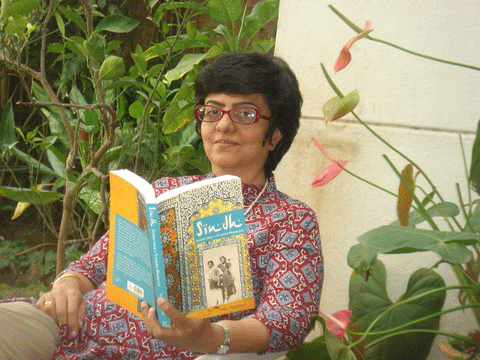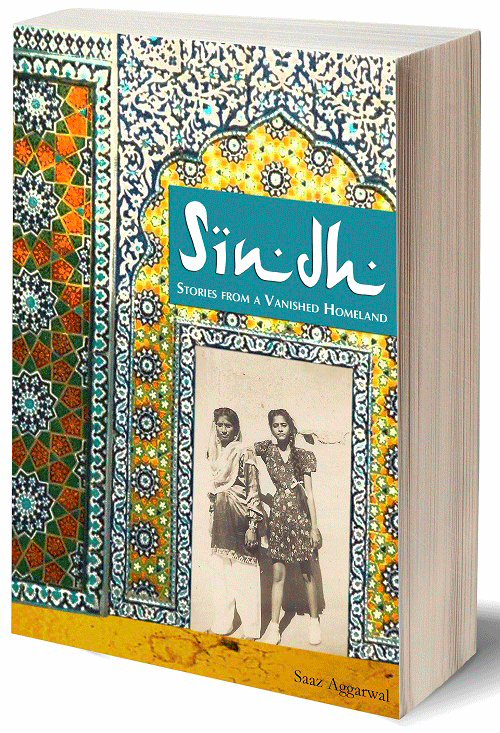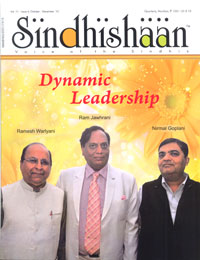SINDH
by - Saaz Aggarwal

On 14 November 1947, the passenger ship SS Jaladurga arrived in Bombay after a 2-day journey from Karachi, carrying evacuees from the newly-created nation of Pakistan. Most of the passengers on Jaladurga that day had never stepped outside Sindh before. They were entering a new life where they would stop speaking their language and set aside the traditions and stories of their ancestors.
65 years later, having asked my mother to tell me about her childhood, I was astounded to learn that, a 13-year-old at the time, she could still remember every detail of that journey and even the date on which she had landed, with her parents and five siblings ranging in age from 4 to 19, in the strange new city where they would make their home.
My mother had never spoken about her childhood before. Yet all these years, the memories that lay on the other side of a divide that could never be re-crossed, had remained fresh inside her. The things she now told me were fascinating. They showed clearly the role of women and how it was changing; family relationships; attitudes towards health and society; the complex polarisation of two communities that had coexisted peacefully for centuries – and a personal insight into the historical events of the time.
My grandfather had been a lawyer and she had sketchy memories of some of his high-profile cases. Intrigued, I began reading all I could to find out more. The lifestyle my mother described was representative of a large population of privileged and educated Sindhis who had moved to Bombay. So I went out and looked for people who could give me stories representative of other aspects of the Sindhi experience and was lucky to find many. In my book you will read stories from people from rural Sindh, people who have participated in Arya Samaj and RSS, lived in refugee camps, resurrected themselves in business, faced discrimination in the communities they settled in, lived in exotic lands as members of ‘Sindworki’ families, felt betrayed and embittered when all their dedicated work and suffering towards a free country resulted in them losing their own land forever.
Too few of the families I met knew the stories of the migrant generation. Almost none were aware of the history of Sindh or the origins of their families. I realised that the generation of Sindhis uprooted by Partition was so focused on succeeding in their new (and often resentful) environment that they did not have the comfort or confidence to pass on their heritage and memories, many painful, to their children.
My book was released on 14 November 2012, 65 years to the day after Devi and Kishinchand Bijlani and their six children, one of whom would one day be my mother, had landed in Bombay. Somehow, by word of mouth, it had already begun selling. Many of the Sindhis I knew personally had bought in bulk to give away as Diwali presents. After the launch, word spread more and I received a long stream of phone calls and emails telling me how much the book had been enjoyed. Many people, both men and women, told me that they had found tears rolling from their eyes as they read.

One person I know, however, approached me at a dinner party one day and said, “Saaz, I tried reading your book but couldn’t get past a few pages. Why would I be interested in the life and daily events of people I don’t know? What a pity you were unable to get interviews with Ram Jethmalani and LK Advani!”
The very next day, I received an email from a reader unknown to me, forwarded by another reader who had got my email id in the process of buying the book. This woman, a Bengali, had grown up in Calcutta and wrote that the book had engrossed and moved her. She also wrote about a Sindhi she remembered from her childhood: He was a tall, well spoken man who used to carry a bundle of saris, selling them from door to door. Mother would offer him tea and mithai whenever he came. He spoke very little about himself other than once suggesting a medicine for a rash Mother had on her elbow. One day he came round with his usual bundle announcing that this would be the last time he would come! He then told Mother that he had managed to "buy" a practice. And then it came out. He was a doctor – a skin specialist – who had left Sindh with literally nothing other than the clothes on his back with his wife and mother. By peddling saris (and they were some of the choicest saris which Mother bought) and very strict budgeting, he had managed to buy a practice going into partnership with a well known skin specialist in Calcutta. I have never forgotten this story which left Mother quite speechless. But then, as my Father said later, it was his sheer hard work and humility that paid dividend. In fact, one of the memories I have of this very fine man was that he never spoke much about himself and never bragged. And he never looked back!
How sad that such fine and remarkable Sindhis have remained invisible, not giving the strong role models our youngsters need! And how sad that the Sindhis who did rise to prominence have not been good brand ambassadors for the community!
My book takes us into Sindh – its history, its beauty, the different aspects of its culture and traditions. Using childhood memories, it reconstructs life in Sindh before and during Partition. While it is a tribute to the community for moving forward in difficult times, leaving behind their cultural heritage to make new lives for themselves – it is also a wake-up call to the Sindhi community that says, hey, enough time has passed; you can look back without those feelings of hostility and betrayal, to see who you are and where you came from.


